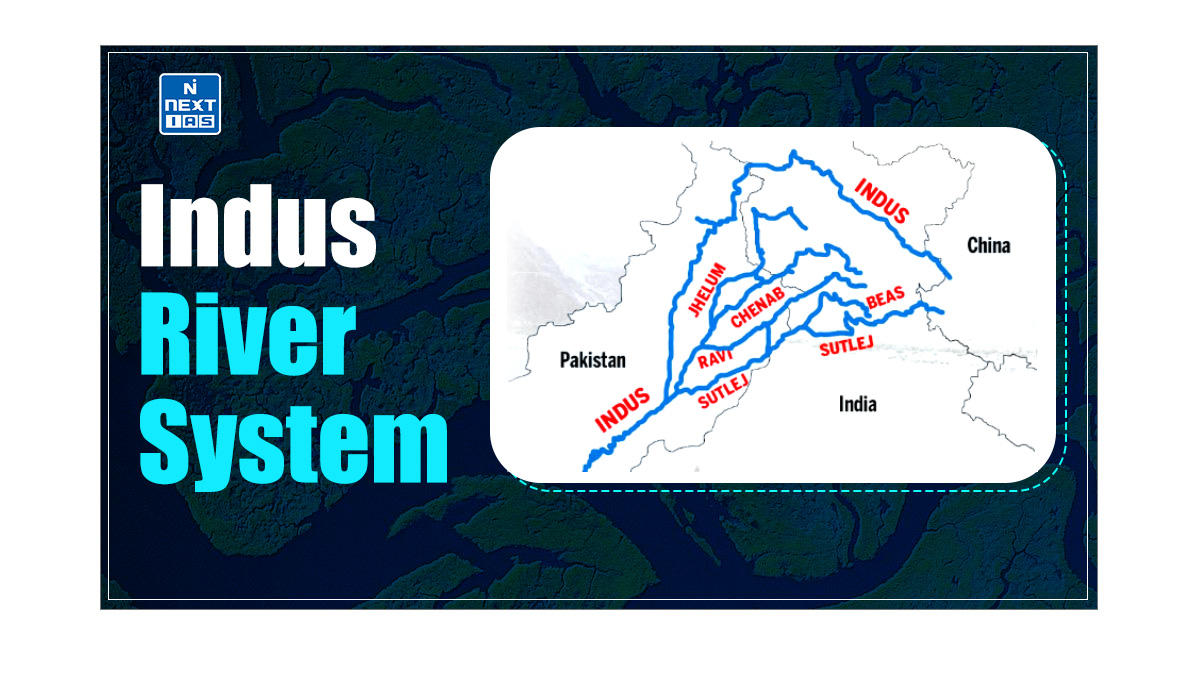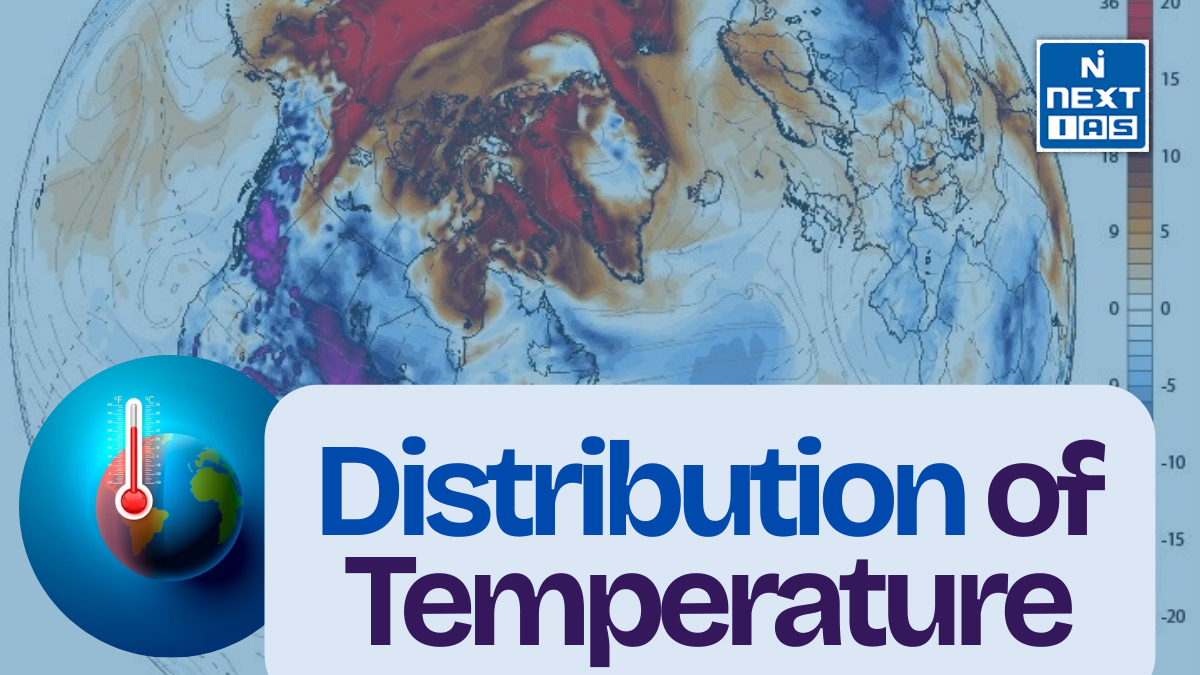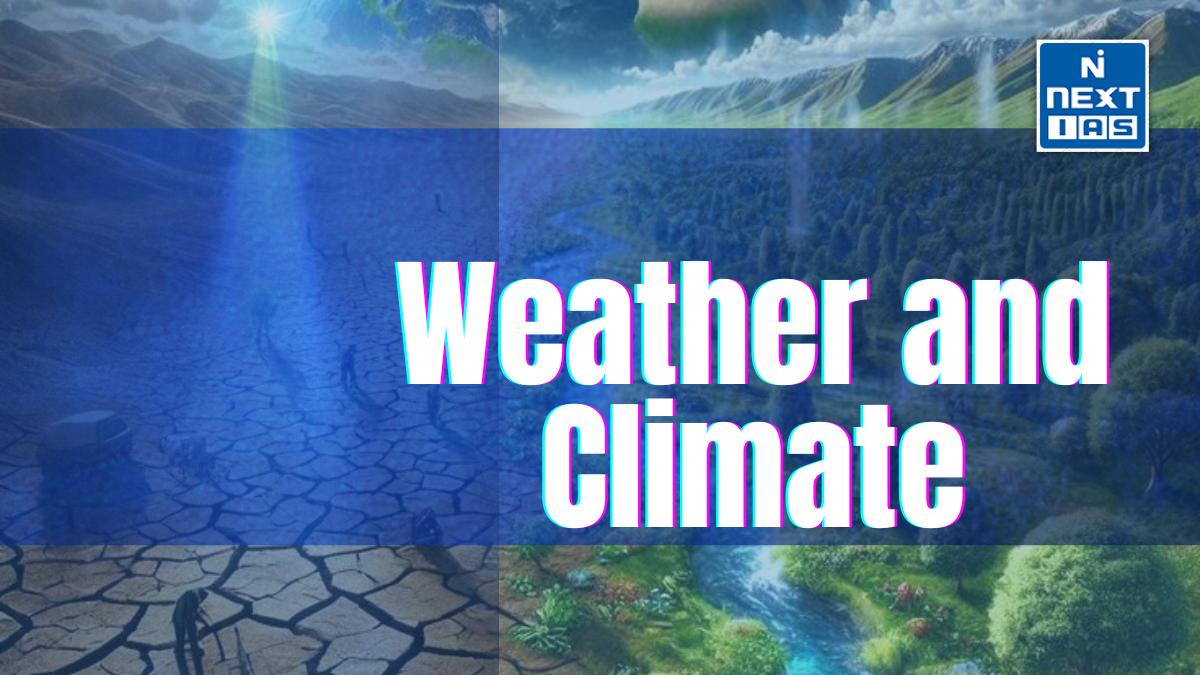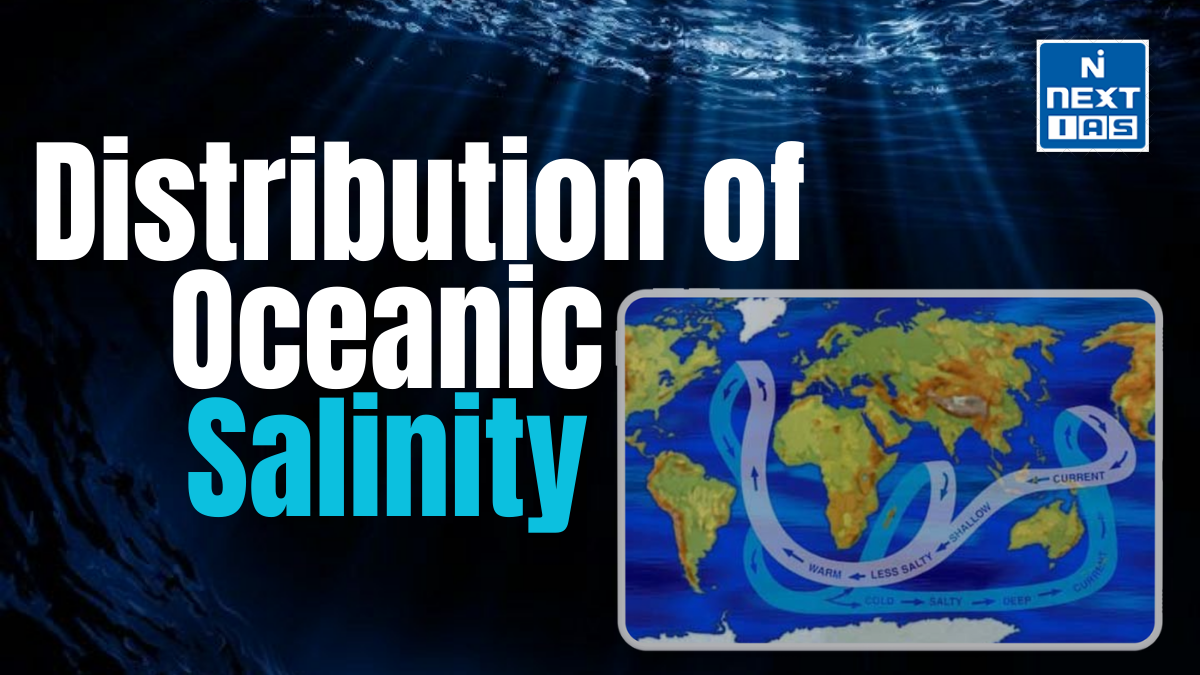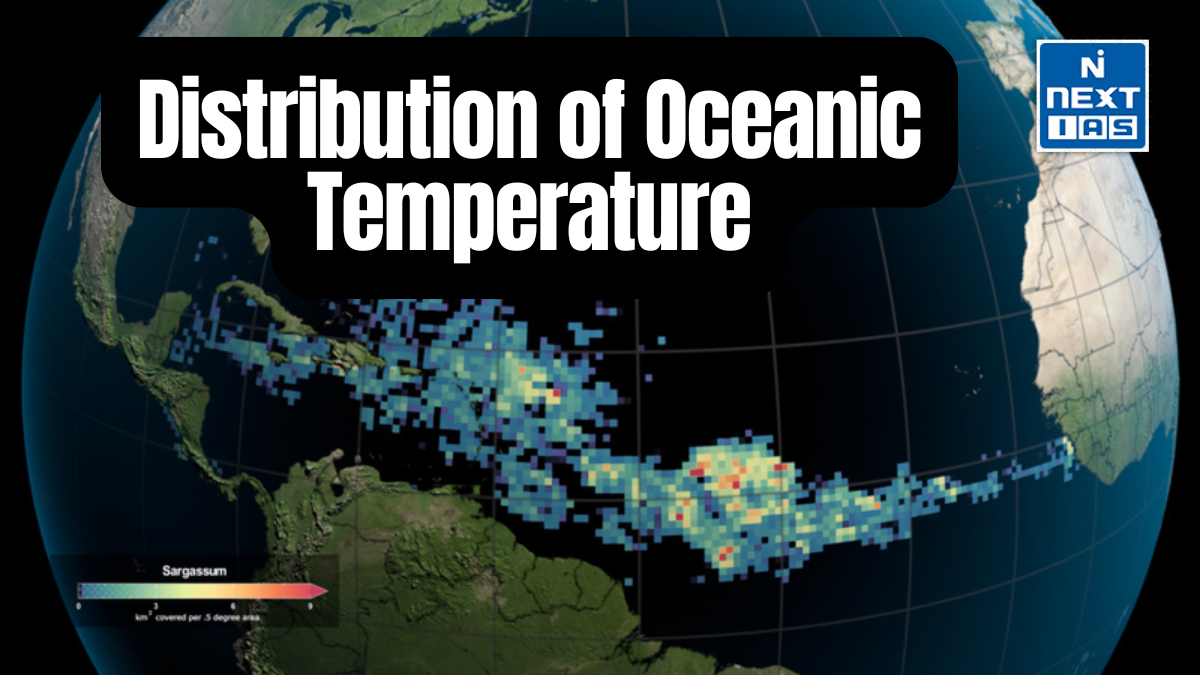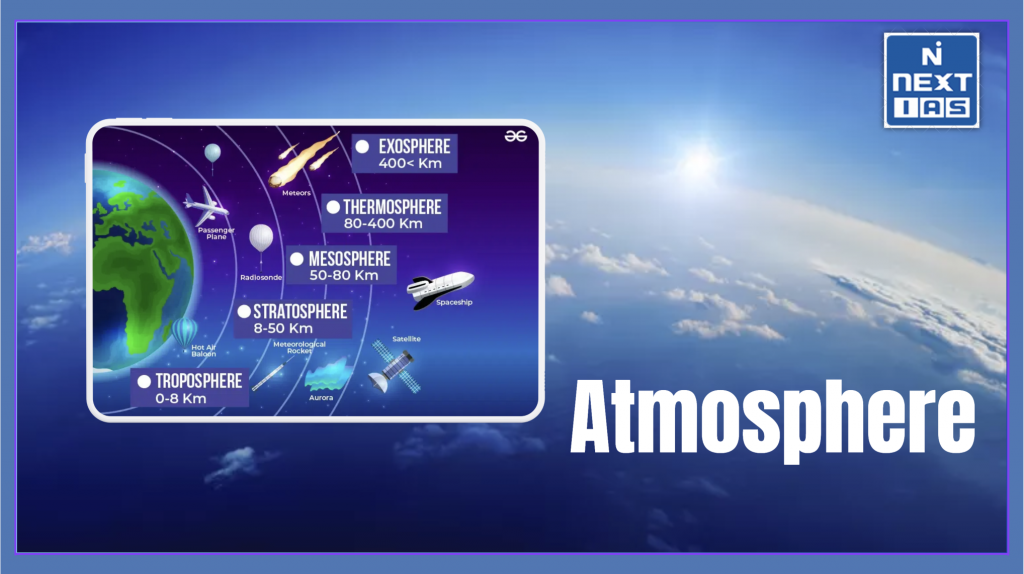
The atmosphere is a vital layer of gases surrounding Earth, protecting life by regulating temperature, shielding from harmful solar radiation, and enabling weather patterns. Composed primarily of nitrogen, oxygen, and trace gases, it supports ecosystems, drives the water cycle, and sustains breathable air, making it essential for life on the planet.
About the Atmosphere
- The atmosphere is a dynamic layer of gases enveloping Earth, essential for sustaining life and shaping the planet’s environment.
- Composed primarily of nitrogen (78%) and oxygen (21%), with trace amounts of argon, carbon dioxide, water vapor, and other gases, it plays a critical role in maintaining Earth’s energy balance.
- Divided into layers—troposphere, stratosphere, mesosphere, thermosphere, and exosphere—the atmosphere regulates temperature, drives weather patterns, and shields life from harmful solar radiation through the ozone layer.
- The troposphere, closest to Earth, supports weather and climate, while the stratosphere contains the ozone critical for blocking ultraviolet rays.
- The atmosphere also facilitates the water cycle, enabling precipitation and sustaining ecosystems.
- Its composition and balance are crucial for life, but human activities, such as pollution and greenhouse gas emissions, threaten its stability. Preserving this delicate layer is vital for ensuring Earth’s habitability and protecting future generations.
Structure of the Atmosphere
The atmosphere is divided into five distinct layers based on temperature and pressure variations. Each layer has unique characteristics and plays a crucial role in Earth’s systems:
- Troposphere:
- The lowest layer, extending up to 8-15 km (varies by location).
- Contains about 75% of the atmosphere’s mass and most of the water vapor.
- Weather phenomena, such as clouds, rain, and wind, occur here.
- Temperature decreases with altitude.
- Stratosphere:
- Lies above the troposphere, extending from about 15 to 50 km.
- Contains the ozone layer, which absorbs and protects from harmful ultraviolet radiation.
- Temperature increases with altitude due to ozone absorption of solar energy.
- Mesosphere:
- Extends from 50 to 85 km above Earth.
- The coldest layer, with temperatures dropping to -90°C.
- Protects Earth by burning up meteoroids.
- Thermosphere:
- Extends from 85 to 600 km.
- Temperatures rise sharply due to solar radiation absorption.
- Hosts phenomena like auroras and satellites.
- Exosphere:
- The outermost layer, extending beyond 600 km into space.
- Contains sparse particles that gradually merge with outer space.
Each layer contributes to maintaining Earth’s environment and supporting life.
Composition of Atmosphere
The Earth’s atmosphere is a mixture of gases that surrounds the planet, providing essential support for life and influencing weather and climate. Its composition is as follows:
Major Components
- Nitrogen (N₂): 78%
- Dominates the atmosphere and plays a critical role in the nitrogen cycle, supporting plant growth.
- Oxygen (O₂): 21%
- Essential for respiration in most living organisms and combustion processes.
- Argon (Ar): 0.93%
- An inert gas with minimal chemical reactivity.
- Carbon Dioxide (CO₂): 0.04% (increasing due to human activities)
- Vital for photosynthesis and a significant greenhouse gas regulating Earth’s temperature.
Trace Gases
- Neon (Ne), Helium (He), Methane (CH₄), Krypton (Kr), Hydrogen (H₂), and others, present in minute quantities but crucial for various natural processes.
Variable Components
- Water Vapor (H₂O): Varies from 0-4% depending on location and conditions; essential for the water cycle and weather phenomena.
- Ozone (O₃): Concentrated in the stratosphere, it protects against harmful UV radiation.
- Particulates: Dust, pollen, and aerosols contribute to cloud formation and atmospheric processes.
The precise balance of these components is crucial for maintaining Earth’s climate and supporting life systems.
Properties of Earth Atmosphere
The Earth’s atmosphere exhibits several unique properties that make it essential for life and environmental stability. Key properties include:
Composition
- Made up of nitrogen (78%), oxygen (21%), and trace gases such as argon, carbon dioxide, and water vapor.
Pressure
- Atmospheric pressure decreases with altitude, highest at sea level (~1013 hPa or 1 atm) and near-zero in outer space.
Temperature
- Varies by altitude and layer:
- Decreases in the troposphere.
- Increases in the stratosphere due to ozone absorption.
- Decreases in the mesosphere and rises again in the thermosphere due to solar radiation.
Density
- Air density decreases with altitude as the number of gas molecules reduces.
Humidity
- The atmosphere can hold varying amounts of water vapor, influencing weather and climate.
Transparency
- Transparent to visible light, allowing sunlight to reach Earth’s surface while blocking harmful radiation.
Mobility
- Constantly in motion, driven by wind, convection currents, and Earth’s rotation, enabling weather systems and air circulation.
Protective Function
- Absorbs harmful solar radiation (UV rays) through the ozone layer and burns meteoroids entering the Earth’s atmosphere.
These properties work together to sustain life, regulate climate, and protect Earth from external threats.
Role of Atmosphere
The atmosphere plays a crucial role in maintaining life and regulating Earth’s environmental systems. Its functions include:
Supporting Life
- Oxygen Supply: Provides oxygen for respiration and carbon dioxide for photosynthesis, essential for plants and animals.
- Water Cycle: Facilitates evaporation, condensation, and precipitation, enabling the distribution of fresh water.
Climate Regulation
- Acts as a thermal blanket, maintaining Earth’s temperature by trapping heat through the greenhouse effect.
- Balances energy by reflecting and absorbing solar radiation, preventing extreme temperature fluctuations.
Protection
- Ozone Layer: Shields life from harmful ultraviolet (UV) radiation.
- Burns up meteoroids entering Earth’s atmosphere, reducing potential damage.
Enabling Weather and Ecosystems
- Drives weather patterns, including wind, rain, and storms, crucial for ecosystems and agriculture.
Medium for Communication
- Transmits sound and supports radio waves, enabling communication technologies.
Global Cycling of Elements
- Participates in the carbon, nitrogen, and oxygen cycles, crucial for sustaining ecosystems and balancing Earth’s systems.
The atmosphere’s diverse roles are integral to life, climate stability, and Earth’s dynamic processes.
Challenges to the Atmosphere
The atmosphere faces numerous challenges, primarily due to human activities, which threaten its balance and health. These challenges include:
Air Pollution
- Emission of harmful substances like particulate matter, sulfur dioxide, and nitrogen oxides from industries, vehicles, and agriculture.
- Impacts human health, causes respiratory diseases, and reduces visibility.
Greenhouse Gas Emissions
- Increased levels of carbon dioxide, methane, and nitrous oxide from burning fossil fuels and deforestation.
- Drives global warming, leading to climate change and extreme weather events.
Ozone Depletion
- Release of chlorofluorocarbons (CFCs) and other ozone-depleting substances damages the ozone layer.
- Increases exposure to harmful ultraviolet radiation, causing skin cancer and harming ecosystems.
Acid Rain
- Sulfur and nitrogen compounds in the atmosphere combine with water vapor to form acidic precipitation.
- Harms forests, aquatic systems, and infrastructure.
Deforestation and Land Use Changes
- Reduces the atmosphere’s ability to absorb carbon dioxide, worsening the greenhouse effect.
Particulate Pollution
- Tiny particles from industrial activities, wildfires, and construction contribute to haze and health issues.
Space Activities
- Increased satellite launches and debris pose risks to the upper atmosphere.
Overpopulation and Urbanization
- Intensifies resource demand, leading to more pollution and atmospheric stress.
Addressing these challenges requires global cooperation and sustainable practices to restore and protect the atmosphere.
Way forward
Protecting the atmosphere requires reducing greenhouse gas emissions, transitioning to renewable energy, enforcing pollution controls, and reforestation. Promoting sustainable practices, advancing clean technologies, and global cooperation through agreements like the Paris Accord are vital. Public awareness and action are crucial to restoring atmospheric balance and ensuring a sustainable future for all.
Conclusion
The atmosphere is a vital shield and life-supporting system for Earth, balancing ecosystems, regulating climate, and enabling life. Preserving its delicate composition is crucial to counter challenges like pollution and climate change. Sustainable practices and global efforts are essential to ensure the atmosphere remains a stable and nurturing environment for all.
GS - 3